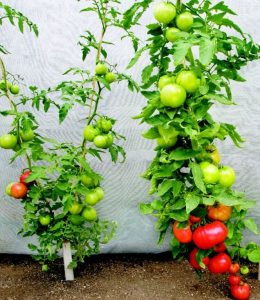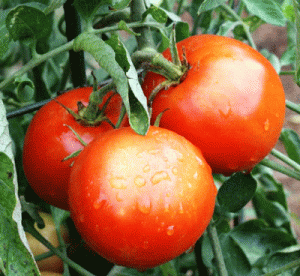Grafted Tomato Plants are the Best!
Our growing season got off to a painful start this year. Frigid temperatures in early May delayed the season by two weeks, and even now the evenings still are chilly. Early cold took its toll on several of my tomato, pepper, and squash plants that normally would have taken off by now and would be thriving. Once a plant stunts or shows signs of weakness it needs to be replaced by a vigorous new plant, and that’s what I’ve done with my casualties. The first week of June is the time to make this transition.

These days tomatoes are being grafted, just like fruit trees, grapes, and roses have been for years. A grafted tomato may seem like and oddity, but compared to ungrafted plants it delivers a greatly improved performance in mountain gardens. These new grafted varieties are the best plants to withstand heat and to increase harvests. The most delicious tomato varieties are the weak and disease prone heirlooms our grandfathers grew. By grafting these better tasting heirloom tomatoes onto a productive, disease resistant rootstock we get the best characteristics of both types. This year most of my garden’s tomato plants are from these new, tasty, and truly awesome grafted varieties.
Grafted tomato plants are bigger, healthier, and produce great tasting crops. The vigorous plants have a greater tolerance for seasonal temperature swings, thereby extending both ends of the growing season. The root system on a grafted tomato grows 4-5 times larger than that of a regular tomato plant. The result is lusher foliage and several more pounds of fruit than from the tomato plants of yesteryear.
Indigo Rose grafted – The 1 to 2 oz cocktail sized fruits have a plummy overtone. The traditional red meat exhibits purple skin when exposed to sun.
San Marzano grafted – One of the few tomatoes that is low in sugar and acid. For canning, paste, and a killer spaghetti sauce, it’s hard to beat. The 4 inch long fruits are very prolific forming in clusters of 4 to 6 fruits.
Pineapple grafted – The best tasting tomato to eat right off the vine. A beefsteak type with huge fruits often striped in red and boasting fewer seeds and more solids. Very aromatic with a fruity aftertaste. This is the one for that ‘real tomato’ experience you just can’t find in the milder, less robust hybrids!
If you use grafted tomato varieties to replace slow starters and those wrecked by our cool spring, be aware that they are planted differently than hybrids are. Do not follow the usual practice of deep planting or mulching, since roots formed on the scion lack the advantages the rootstock brings to the union. Instead, keep the graft well above ground and pinch off any suckers formed beneath the graft. Handle grafted plants gently and stake them well, providing ample support to avoid damaging the graft.
A tomato is a solar powered sugar-making machine. For the first month, all of the sugar a tomato produces is directed towards new foliage. During this stage, tomato plants grow very rapidly, doubling in size every 14 days. Eventually, a plant makes more sugar than the single growing tip can use, which signals the vine to make new side branches and to start blooming. This usually happens when the vine is just over a foot tall.
If unsupported the increasing weight of new fruit and multiple side branches forces the plant down onto the ground. Once the main stem is horizontal, there is an increased tendency to branch even more. Left to its own, a vigorous indeterminate tomato plant can easily cover a 4 x 4 foot area with as many as 10 stems and less fruiting vigor.
The rapid growth of a healthy tomato plant often leads to problems. Whether the plant is grafted, heirloom, or traditional your pruning techniques will affect plant growth and fruit production.
Suckers form in the axils between the leaves and the main stem. Encourage a strong main stem by removing all suckers below the first flower cluster; this is especially important for grafted tomatoes.
When a tomato vine lies on the ground, or when its growth is extremely dense, many of its leaves are forced into permanent shade, greatly reducing the amount of sugar they produce. If a leaf uses more sugar than it makes, eventually it will yellow and drop off. Strategic pruning maximizes the efficiency of photosynthesis while minimizing the risk of disease. This is best accomplished by ensuring each leaf has plenty of space and is supported off the ground.
 A properly pruned and supported single stem tomato plant presents all its leaves to the sun. Most of the sugar produced is directed to developing fruits, since the only competition is a single growing tip. The result is large fruits that are steadily produced until frost. If more stems are allowed to develop, some of this precious sugar production is diverted from the fruit to multiple growing tips. A pruned and staked plant will produce larger fruit 2-3 weeks earlier than an unpruned, unsupported vine. Grow fruits, not more tips!
A properly pruned and supported single stem tomato plant presents all its leaves to the sun. Most of the sugar produced is directed to developing fruits, since the only competition is a single growing tip. The result is large fruits that are steadily produced until frost. If more stems are allowed to develop, some of this precious sugar production is diverted from the fruit to multiple growing tips. A pruned and staked plant will produce larger fruit 2-3 weeks earlier than an unpruned, unsupported vine. Grow fruits, not more tips!
To ensure continuous fruiting well into fall, every 6 weeks apply ‘Tomato & Vegetable Food’ (4-4-6). Keeping their vines well fed, cleaned, upright, and always facing the sun, your tomato plants will be problem- free and produce tomatoes by the dozen.
Until next week, I’ll see you in the garden center.

